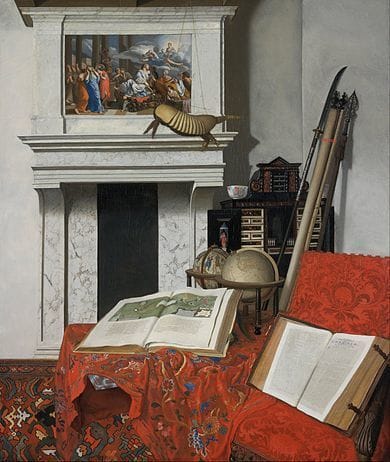

Room Corner with Curiosities
Jan Van Der Heyden
Van der Heyden painted his still life masterpiece Room Corner with Curiosities at the age of 75 in 1712, the year he died. Now in the Museum of Fine Arts in Budapest the composition reprises the themes of his earlier still lifes with special attention given to the vanitas symbolism. The Bible in the foreground is opened at the well-known line from Ecclesiastes: 'Vanity of vanities, all is vanity'. This message may have resonated particularly with the artist who was nearing the end of his life. The objects present in the composition point to the various aspects of worldly culture, not just wealth but also noble intellectual aspirations. The atlas is again opened on the page showing the fortifications of Bergen-op-Zoom. Other exotic objects reference all the routes plowed by the Dutch merchant fleets: a Turkish carpet, Chinese silk and porcelain, Japanese weapons and a stuffed armadillo from South America. Classical culture, the cradle of European civilization, is represented in the picture above the fireplace, which depicts the tragedy of Dido, and the German cabinet, which is decorated with an image of Minerva. Terrestrial and celestial globes introduce a universal dimension into the mix of symbols.
[https://en.wikipedia.org/wiki/Jan_van_der_Heyden]
The Bible in the foreground is open at the famous line from Ecclesiastes: Vanity of vanities, all is vanity. As if a stern lecturer were explaining with a cane in his hand, the book seems to force the message upon us: all earthly knowledge and beauty are futile, for in the end comes death, and all that man has accumulated vanishes.
Such 'vanitas still-lifes' have a long tradition, though initially they condemned only revelry. Here however the objects represent the entire worldly culture, not just the opulent but also the noble. We set out from Willem Blaeu's atlas, the origin of every Dutch expedition, which lies open where the country was 'born': the first victory of the war of independence was won at Bergen. Then we are taken on a journey over all the routes of the glorious Dutch merchant fleets, with a Turkish carpet, Chinese silk and porcelain, Japanese weapons and a stuffed armadillo from South America. Nor is classical culture, the cradle of European civilization, absent: above the fireplace is the tragedy of Dido, and the German cabinet is decorated with an image of Minerva. Finally, terrestrial and celestial globes raise the ensemble to the universal dimension.
Van der Heyden painted this summative masterpiece at the age of 75, the year he died, and the concept is obviously linked to the sense of the end drawing near. Though he may have felt it vanity, he did after all make a final display of the virtuoso skill which has protected his name from oblivion ever since.
Axel Vécsey
[https://www.google.com/culturalinstitute/beta/asset/room-corner-with-curiosities/7AEcpjrWqeXoxw]
Uploaded on Feb 27, 2018 by Suzan Hamer
Jan Van Der Heyden
artistArthur
Wait what?
